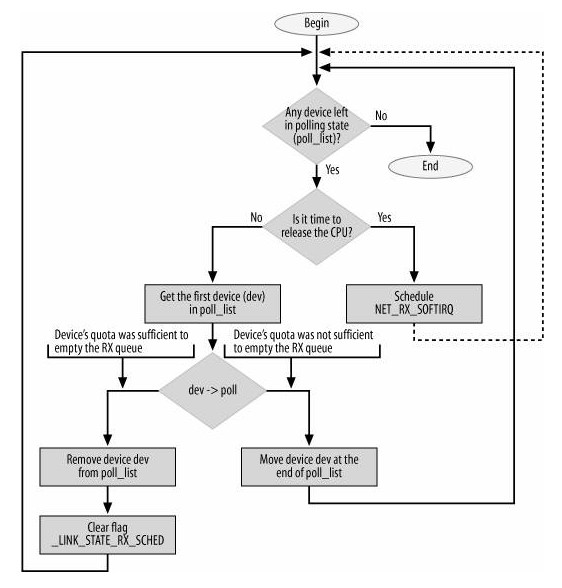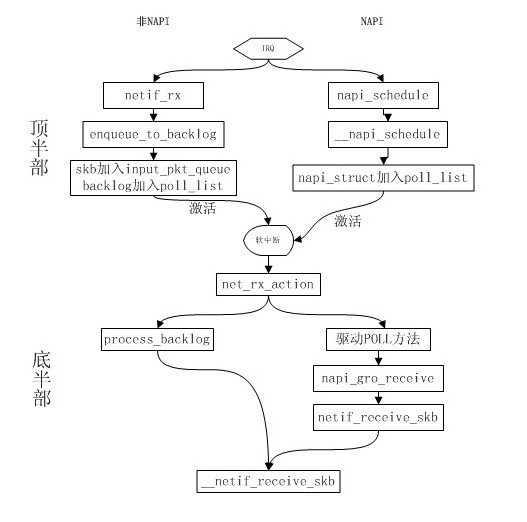本文主要内容:简单分析NAPI的原理和实现。
内核版本:2.6.37
Author:zhangskd @ csdn
概述
NAPI是linux新的网卡数据处理API,据说是由于找不到更好的名字,所以就叫NAPI(New API),在2.5之后引入。
简单来说,NAPI是综合中断方式与轮询方式的技术。
中断的好处是响应及时,如果数据量较小,则不会占用太多的CPU事件;缺点是数据量大时,会产生过多中断,
而每个中断都要消耗不少的CPU时间,从而导致效率反而不如轮询高。轮询方式与中断方式相反,它更适合处理
大量数据,因为每次轮询不需要消耗过多的CPU时间;缺点是即使只接收很少数据或不接收数据时,也要占用CPU
时间。
NAPI是两者的结合,数据量低时采用中断,数据量高时采用轮询。平时是中断方式,当有数据到达时,会触发中断
处理函数执行,中断处理函数关闭中断开始处理。如果此时有数据到达,则没必要再触发中断了,因为中断处理函
数中会轮询处理数据,直到没有新数据时才打开中断。
很明显,数据量很低与很高时,NAPI可以发挥中断与轮询方式的优点,性能较好。如果数据量不稳定,且说高不高
说低不低,则NAPI则会在两种方式切换上消耗不少时间,效率反而较低一些。
实现
来看下NAPI和非NAPI的区别:
(1) 支持NAPI的网卡驱动必须提供轮询方法poll()。
(2) 非NAPI的内核接口为netif_rx(),NAPI的内核接口为napi_schedule()。
(3) 非NAPI使用共享的CPU队列softnet_data->input_pkt_queue,NAPI使用设备内存(或者
设备驱动程序的接收环)。
(1) NAPI设备结构
- /* Structure for NAPI scheduling similar to tasklet but with weighting */
-
- struct napi_struct {
- /* The poll_list must only be managed by the entity which changes the
- * state of the NAPI_STATE_SCHED bit. This means whoever atomically
- * sets that bit can add this napi_struct to the per-cpu poll_list, and
- * whoever clears that bit can remove from the list right before clearing the bit.
- */
- struct list_head poll_list; /* 用于加入处于轮询状态的设备队列 */
- unsigned long state; /* 设备的状态 */
- int weight; /* 每次处理的最大数量,非NAPI默认为64 */
- int (*poll) (struct napi_struct *, int); /* 此设备的轮询方法,非NAPI为process_backlog() */
-
- #ifdef CONFIG_NETPOLL
- ...
- #endif
-
- unsigned int gro_count;
- struct net_device *dev;
- struct list_head dev_list;
- struct sk_buff *gro_list;
- struct sk_buff *skb;
- };
(2) 初始化
初始napi_struct实例。
- void netif_napi_add(struct net_device *dev, struct napi_struct *napi,
- int (*poll) (struct napi_struct *, int), int weight)
- {
- INIT_LIST_HEAD(&napi->poll_list);
- napi->gro_count = 0;
- napi->gro_list = NULL;
- napi->skb = NULL;
- napi->poll = poll; /* 设备的poll函数 */
- napi->weight = weight; /* 设备每次poll能处理的数据包个数上限 */
-
- list_add(&napi->dev_list, &dev->napi_list); /* 加入设备的napi_list */
- napi->dev = dev; /* 所属设备 */
-
- #ifdef CONFIG_NETPOLL
- spin_lock_init(&napi->poll_lock);
- napi->poll_owner = -1;
- #endif
- set_bit(NAPI_STATE_SCHED, &napi->state); /* 设置NAPI标志位 */
- }
(3) 调度
在网卡驱动的中断处理函数中调用napi_schedule()来使用NAPI。
- /**
- * napi_schedule - schedule NAPI poll
- * @n: napi context
- * Schedule NAPI poll routine to be called if it is not already running.
- */
-
- static inline void napi_schedule(struct napi_struct *n)
- {
- /* 判断是否可以调度NAPI */
- if (napi_schedule_prep(n))
- __napi_schedule(n);
- }
判断NAPI是否可以调度。如果NAPI没有被禁止,且不存在已被调度的NAPI,
则允许调度NAPI,因为同一时刻只允许有一个NAPI poll instance。
- /**
- * napi_schedule_prep - check if napi can be scheduled
- * @n: napi context
- * Test if NAPI routine is already running, and if not mark it as running.
- * This is used as a condition variable insure only one NAPI poll instance runs.
- * We also make sure there is no pending NAPI disable.
- */
-
- static inline int napi_schedule_prep(struct napi_struct *n)
- {
- return !napi_disable_pending(n) && !test_and_set_bit(NAPI_STATE_SCHED, &n->state);
- }
-
- static inline int napi_disable_pending(struct napi_struct *n)
- {
- return test_bit(NAPI_STATE_DISABLE, &n->state);
- }
-
- enum {
- NAPI_STATE_SCHED, /* Poll is scheduled */
- NAPI_STATE_DISABLE, /* Disable pending */
- NAPI_STATE_NPSVC, /* Netpoll - don't dequeue from poll_list */
- };
NAPI的调度函数。把设备的napi_struct实例添加到当前CPU的softnet_data的poll_list中,
以便于接下来进行轮询。然后设置NET_RX_SOFTIRQ标志位来触发软中断。
- void __napi_schedule(struct napi_struct *n)
- {
- unsigned long flags;
- local_irq_save(flags);
- ____napi_schedule(&__get_cpu_var(softnet_data), n);
- local_irq_restore(flags);
- }
-
- static inline void ____napi_schedule(struct softnet_data *sd, struct napi_struct *napi)
- {
- /* 把napi_struct添加到softnet_data的poll_list中 */
- list_add_tail(&napi->poll_list, &sd->poll_list);
- __raise_softirq_irqoff(NET_RX_SOFTIRQ); /* 设置软中断标志位 */
- }
(4) 轮询方法
NAPI方式中的POLL方法由驱动程序提供,在通过netif_napi_add()加入napi_struct时指定。
在驱动的poll()中,从自身的队列中获取sk_buff后,如果网卡开启了GRO,则会调用
napi_gro_receive()处理skb,否则直接调用netif_receive_skb()。
POLL方法应该和process_backlog()大体一致,多了一些具体设备相关的部分。
(5) 非NAPI和NAPI处理流程对比
以下是非NAPI设备和NAPI设备的数据包接收流程对比图:
NAPI方式在上半部中sk_buff是存储在驱动自身的队列中的,软中断处理过程中驱动POLL方法调用
netif_receive_skb()直接处理skb并提交给上层。
- /**
- * netif_receive_skb - process receive buffer from network
- * @skb: buffer to process
- * netif_receive_skb() is the main receive data processing function.
- * It always succeeds. The buffer may be dropped during processing
- * for congestion control or by the protocol layers.
- * This function may only be called from softirq context and interrupts
- * should be enabled.
- * Return values (usually ignored):
- * NET_RX_SUCCESS: no congestion
- * NET_RX_DROP: packet was dropped
- */
-
- int netif_receive_skb(struct sk_buff *skb)
- {
- /* 记录接收时间到skb->tstamp */
- if (netdev_tstamp_prequeue)
- net_timestamp_check(skb);
-
- if (skb_defer_rx_timestamp(skb))
- return NET_RX_SUCCESS;
-
- #ifdef CONFIG_RPS
- ...
- #else
- return __netif_receive_skb(skb);
- #endif
- }
__netif_receive_skb()在上篇blog中已分析过了,接下来就是网络层来处理接收到的数据包了。





